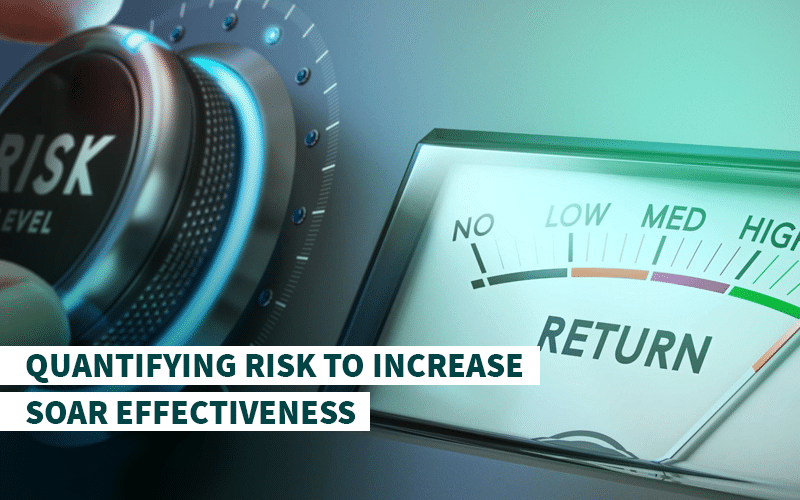
Demystifying the Cognitive Capabilities of SOAR
August 24, 2021
Powerful Threat Detection and Response with a Combination of XDR and SOAR
September 19, 2021
Demystifying the Cognitive Capabilities of SOAR
August 24, 2021
Powerful Threat Detection and Response with a Combination of XDR and SOAR
September 19, 2021Quantifying Risk To Increase SOAR Effectiveness

The thankless job of the security analyst is a constant juggling act. How do I know which threat to address first? Is this alert the one that I can afford to ignore? When security professionals spend up to 30% of their time focusing on false alerts, shifting through the overwhelming volume of false positives can seriously impact cybersecurity and incident response.
Security Orchestration, Automation, and Response (SOAR) platforms are designed to save professionals time and resources in threat identification, containment, and eradication. SIRP Security Score (S3) is designed to calculate risk scores based on 25 different parameters and automatically present the most important events based on the organization's landscape.
Analysis Paralysis: The Problem of Disorganised Threat Alerts
Being unable to prioritize incoming threats leads to dead stops in a security analyst’s workflow. This “analysis paralysis” stops professionals from making effective decisions because of an overload of incoming information.
Incoming threats can be difficult to manually sift through, even for highly experienced security professionals. False positives are rife and cause teams to make bad calls - sometimes by prioritizing the wrong threat, sometimes by mistaking a genuine threat as a false positive.
Escaping analysis paralysis is difficult. Using SOAR platforms that quantify and contextualize threats is the first step to escaping the problem. But how does quantification actually aid in the decision-making process?
How Quantification Can Help
Quantification is simply measuring. In the case of cybersecurity, potential monetary loss or a security score quantifying the overall threat are examples of objective measurements. The main gain is to get rid of low-value risk descriptions such as “high risk” which can confuse or mislead non-security personnel.
Making informed decisions can greatly reduce the effects of a cyber-attack. Security leadership teams need a toolkit that automatically arranges and prioritizes the potential threat according to the organization-specific context and the apparent level of threat.
SIRP Security Score is designed to cut down on inefficient practices. Using S3 removes the analysis paralysis of unintelligent SOAR platforms and gives a security team the ability to shift focus to effective incident response as critical threats arrive in the context of the business and through quantifiable means.
Creating A SIRP Security Score
Organization-specific context and machine learning algorithms generate a score called S3. This score along with the associated alerts, vulnerabilities, and threat intel signpost the most pressing issue for the SecOps team to address first and allow cybersecurity team members to base their judgment on an objective metric.
Additionally, S3 strengthens a team when it comes to justifying security responses in retrospect or creating a case for making changes to the security response infrastructure.
Prioritizing Risk: Organization In Orchestration
Applying S3 to the day-to-day workflow allows for serious incidents to be handled first. Let’s take an example of a security risk alert that has been sent to the InfoSec team:
- The security analyst receives a report of two workstations being potentially compromised
- The first workstation belongs to a receptionist
- The second workstation belongs to the CEO
- S3 calculates which workstation demands immediate attention
- The security team scrambles to attend to high-scoring risks before changing focus to the lesser threat
The S3 calculation is based on business-specific risk analysis. By examining internal and external threat factors, a compromised high-authority system receives a higher security score - access to sensitive materials and data, network authority (possibly including admin permissions), and the threat of spear-phishing are all significant threat factors.
This workflow is completely automated through SIRP and quickly creates a score as an objective metric for security professionals.
Using S3 To Minimize The Monetary Impact of Cyber Threats
Security protocols and the actual worth of effective defenses can seem like a foreign language to C-level executives. But S3 contains tools for making threat intelligence accessible to everyone.
How Does S3 Work In Practice?
In practice, implementing quantifiable reports helps in two ways:
- Threats are identified and organized by the SOAR platform by severity to help security professionals focus on cutting out the danger through informed decisions
- Non-technical stakeholders understand the severity of the risks that the businesses faces and the long-term impact of neglecting the risk
Security analysts receive automated reports created on the back of orchestrated threat response practices. Not only does this allow rapid response, but also acts as an objective report that can show exactly how threats can cause damage to an organization.
Is S3 Right For My Business?
Using SIRP Security Score to analyze the incoming problems is key to effective security response practices. Not only are the security processes orchestrated and automated, but intelligent threat analysis allows your team to prioritize the threats and to create solutions appropriately.
As cybersecurity becomes even more important despite industry-wide budget constraints, teams need efficiency. Quantifying threats creates a positive response culture that is backed with automated risk assessment and hierarchical sorting of response urgency.
Using the SIRP Security Score can save your organization time and money in the short and long term through orchestration and automation of your security operations. When security teams are empowered to quickly respond to cyber-attacks, organizations don’t suffer from malware-induced downtime or painful data breaches. Protect your money and your reputation with S3.
To learn more about SIRP, arrange a personalized demo.

